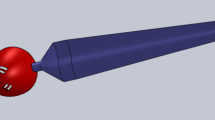Abstract
A new method for characterizing fiber bending flexibility was developed by worm-like chain model proposed by Kratky-Porod,[1] which was first introduced to the pulp and paper field in this study. For the three types of pulps, the experimental results were compared with the KP chain model, and the resulting determination coefficients were all above 0.95, which proved that the model was feasible to be applied to these three fibers. The relation between fiber bending rigidity and that of cellulosic chains inside was discussed to deduce the fiber bending flexibility. The flexibility of an individual fiber can be approximated as the contribution of that of all the cellulose chains inside. By this method, the fiber flexibility values were determined to be in the range of 0.6×1011−3.5×1011 N−1·m−2, which was comparable to that of the conventional methods recorded in the literature.
Similar content being viewed by others
References
Kratky, O.; Porod, G. Rontgenuntersuchung geloster Fadenmoleküle. Recueil des Travaux Chimiques Des Pays Bas 1949, 68, 1106–1122.
Huber, P.; Carre, B.; Petit-Conil, M. The influence of TMP fibre flexibility on flocculation and formation. Bioresourees 2008, 3, 1218–1227.
Page, D. H. A theory for the tensile strength of paper. Tappi J. 2018, 17, 583–590.
Yan, D. B.; Li, K. C. Wet fiber shear flexibility and its contribution to the overall transverse deformation of fibers. J. Mater. Sci. 2008, 43, 7210–7218.
Petit-Conil, M.; Cochaux, A.; De Choudens, C. Mechanical pulp characterization: a new and rapid method to evaluate fibre flexibility. Pap. Timber 1994, 76, 657–662.
Chandra, R. P.; Wu, J.; Saddler, J. N. The application of fibre quality analysis (FQA) and cellulose accessibility measurements to better elucidate the impact of fibre curls and kinks on the enzymatic hydrolysis of fibres. ACS Sustain. Chem. Eng. 2019, 7, 8827–8833.
Rusu, M.; Mörseburg, K.; Gregersen, Ø.; Yamakawa, A.; Liukkonen, S. Relation between fibre flexibility and cross-sectional properties. Bioresources 2011, 6, 641–655.
Tam Doo, P. A.; Kerekes, R. J. A method to measure wet fiber flexibility. Tappi 1981, 64, 113–116.
Tam Doo, P. A.; Kerekes, R. J. Flexibilities of wet pulp fibers. Pulp and Paper Canada 1982, 83, 46–50.
Samuelsson, L. G. Measurement of the stiffness of fibers. Svensk Papperstidn 1963, 66, 544–546.
Pettersson, T.; Hellwig, J.; Gustafsson, P. J.; Stenstrom, S. Measurement of the flexibility of wet cellulose fibres using atomic force microscopy. Cellulose 2017, 24, 4139–4149.
Fischer, W.J.; Lorbach, C.; Jajcinovic, M. Measured and calculated bending stiffness of individual fibers. In Progress in paper physics seminar. 2014, Raleigh, NC, USA.
Yan, D. B.; Li, K. C. Measurement of wet fiber flexibility by confocal laser scanning microscopy. J. Mater. Sci. 2018, 43, 2869–2878.
Yan, D. B.; Li, K. C.; Zhou, Y. J. Measurement of wet fiber flexibility of mechanical pulp fibers by confocal laser scanning microscopy. Tappi J. 2008, 7, 25–31.
Nilsson, B.; Wågberg, L.; Gray, D. Conformability of wet pulp fibres at small length scales. in The fundamentals of papermaking processes. 2021, Oxford, UK.
Bergander, A.; Salmén, L. The transverse elastic modulus of the native wood fibre wall. J. Pulp Paper Sci. 2000, 26, 234–238.
Dondos, A.; Tsitsilianis, C. Viscometric study of extremely dilute macromolecular solutions: critical concentration c and the intrinsic viscosity of the polystyrene through scaling laws. The values of the Huggins constant. Polym. Int. 1992, 28, 151–156.
Kes, M.; Christensen, B. E. A re-investigation of the Mark-Houwink-Sakurada parameters for cellulose in Cuen: a study based on size-exclusion chromatography combined with multi-angle light scattering and viscometry. J. Chromatogr. A 2013, 1281, 32–37.
Yamakawa, H.; Yoshizaki, T. in Helical wormlike chains in polymer solutions. Vol. 2E, Springer, Berlin/Heidelberg, New York, 2016, p. 21.
Mehandzhiyski, A. Y.; Zozoulenko, I. A review of cellulose coarsegrained models and their applications. Polysaccharides 2021, 2, 257–270.
Matsuyama, A. Conformational transitions of a semiflexible polymer in nematic solvents. Phys. Rev. E 2003, 67, 42701–42701.
Theo, O. Physics of tightly curved semiflexible polymer chains. Macromolecules 1993, 26, 6897–6902.
Peter, Z. Order in cellulosics: historical review of crystal structure research on cellulose. Carbohydr. Polym. 2021, 254, 117417.
Heussinger, C.; Bathe, M.; Frey, E. Statistical mechanics of semiflexible bundles of wormlike polymer chains. Phys. Rev. Lett. 2007, 99, 048101.
Meyer, K. H.; Mish, L. Positions of atoms in the new spatial model of cellulose. Helv. Chim. Acta 1937, 20, 232–244.
Acknowledgments
This work was financially supported by the National Natural Science Foundation of China (No. 21534002) and National Key R&D Program of China (No. 2019YFC1520402).
Author information
Authors and Affiliations
Corresponding authors
Additional information
Notes
The authors declare no competing financial interest.
Rights and permissions
About this article
Cite this article
**, C., Yu, H., Wu, CF. et al. Fiber Bending Flexibility Evaluation by Worm-like Chain Model. Chin J Polym Sci 40, 526–531 (2022). https://doi.org/10.1007/s10118-022-2694-4
Received:
Accepted:
Published:
Issue Date:
DOI: https://doi.org/10.1007/s10118-022-2694-4




